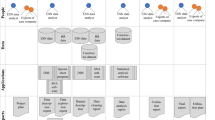Abstract
Interactions among employees promote spread of infectious diseases at workplaces. Enterprise architecture provides rich information about organizational structure and its relations to other elements in an enterprise. This paper develops a workplace topology model as a sub-set of enterprise architecture to analyze both static and dynamic interactions among the employees and to monitor and to limit spread of infectious diseases. The model is developed as a multi-layer graph combining organizational, facility and sensing layers. The graph analytical methods are elaborated to analyze the interactions. The analysis provides inputs to spread of infectious diseases risk assessment models. The application of the graph analytics methods is demonstrated using an example from an Information Technology consulting company producing both software and hardware products.
Access this chapter
Tax calculation will be finalised at checkout
Purchases are for personal use only
Similar content being viewed by others
References
Molinaro, M., Romano, P., Sperone, G.: The organizational side of a disruption mitigation process: exploring a case study during the COVID-19 pandemic, Operations Management Research, in press (2022)
World Health Organization Homepage: https://www.who.int/publications/i/item/WHO-2019-nCoV-workplace-actions-policy-brief-2021-1. Last accessed 07 March 2022
Koh, D.: Migrant workers and COVID-19. Occupational and Environmental Medicine 9, 634–636 (2020)
Shaw, J., et al.: Working in a bubble: How can businesses reopen while limiting the risk of COVID-19 outbreaks? CMAJ 192(44), E1362–E1366 (2020)
Song, M., van der Aalst, W.M.P.: Towards comprehensive support for organizational mining. Decision Support Systems 46(1), 300–317 (2008)
Arnicans, G., Niedrite, L., Solodovnikova, D., Virbulis, J., Zemnickis, J.: Towards a System to Monitor the Virus’s Aerosol-Type Spreading. In: Byrski, A., Czachórski, T., Gelenbe, E., Grochla, K., Murayama, Y. (eds.) Computer Science Protecting Human Society Against Epidemics. ANTICOVID 2021. IFIP Advances in Information and Communication Technology, vol. 616. Springer, Cham (2021). https://doi.org/10.1007/978-3-030-86582-5_9
Chakravarthy, S., Santra, A., Komar, K.S.: Why multilayer networks instead of simple graphs? modeling effectiveness and analysis flexibility and efficiency!. In: Madria, S., Fournier-Viger, P., Chaudhary, S., Reddy, P. (eds.) Big Data Analytics. BDA 2019. Lecture Notes in Computer Science, vol. 11932. Springer, Cham (2019). https://doi.org/10.1007/978-3-030-37188-3_14
de Kinderen, S., Kaczmarek-Heß, M.: On model-based analysis of organizational structures: an assessment of current modeling approaches and application of multi-level modeling in support of design and analysis of organizational structures. Softw Syst Model 19, 313–343 (2020). https://doi.org/10.1007/s10270-019-00767-4
Zimmermann, A., Schmidt, R., Sandkuhl, K., Wißotzki, M., Jugel, D., Möhring, M.: Digital enterprise architecture - transformation for the internet of things. 2015 IEEE 19th International Enterprise Distributed Object Computing Workshop, pp. 130–138 (2015). https://doi.org/10.1109/EDOCW.2015.16
Pereira, D.C., Almeida, J.P.A.: Representing organizational structures in an enterprise architecture language. In: Proceedings of the 6th Workshop on Formal Ontologies meet Industry, CEUR Workshop Proceedings, vol. 1333 (2014)
Smajevic, M., Bork, D.: Towards graph-based analysis of enterprise architecture models. In: Ghose, A. et al. (eds.) Conceptual Modeling. ER 2021. Lecture Notes in Computer Science, vol. 13011. Springer, Cham (2021)
Mauras, S., et al.: Mitigating COVID-19 outbreaks in workplaces and schools by hybrid telecommuting, PLoS Computational Biology 17 (2021)
Buonanno, G., Stabile, L., Morawska, L.: Estimation of airborne viral emission: quanta emission rate of SARS-CoV-2 for infection risk assessment. Environment international 141 (2020)
Lankhorst, M.: Enterprise Architecture at Work: Modelling, Communication and Analysis. Springer Berlin (2013)
Zhu, Y., et al.: Early warning of COVID-19 via wastewater-based epidemiology: potential and bottlenecks. Science of the Total Environment 767 (2021)
Kivelä, M., Arenas, A., Barthelemy, M., Gleeson, J.P., Moreno, Y., Porter, M.A.: Multilayer networks. Journal of Complex Networks 2(3), 203–271 (2014)
Acknowledgements
Project “Platform for the Covid-19 safe work environment” (ID. 1.1.1.1/21/A/011) is founded by European Regional Development Fund specific objective 1.1.1 «Improve research and innovation capacity and the ability of Latvian research institutions to attract external funding, by investing in human capital and infrastructure». The project is co-financed by REACT-EU funding for mitigating the consequences of the pandemic crisis.
Author information
Authors and Affiliations
Corresponding author
Editor information
Editors and Affiliations
Rights and permissions
Copyright information
© 2023 The Author(s), under exclusive license to Springer Nature Switzerland AG
About this paper
Cite this paper
Grabis, J. (2023). Workplace Topology Model for Assessment of Static and Dynamic Interactions Among Employees. In: Sales, T.P., Proper, H.A., Guizzardi, G., Montali, M., Maggi, F.M., Fonseca, C.M. (eds) Enterprise Design, Operations, and Computing. EDOC 2022 Workshops . EDOC 2022. Lecture Notes in Business Information Processing, vol 466. Springer, Cham. https://doi.org/10.1007/978-3-031-26886-1_14
Download citation
DOI: https://doi.org/10.1007/978-3-031-26886-1_14
Published:
Publisher Name: Springer, Cham
Print ISBN: 978-3-031-26885-4
Online ISBN: 978-3-031-26886-1
eBook Packages: Computer ScienceComputer Science (R0)




